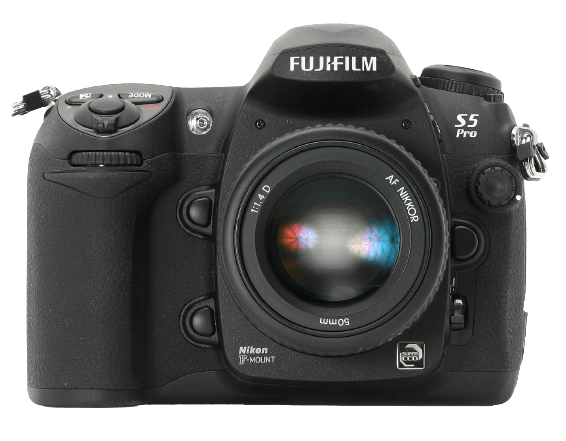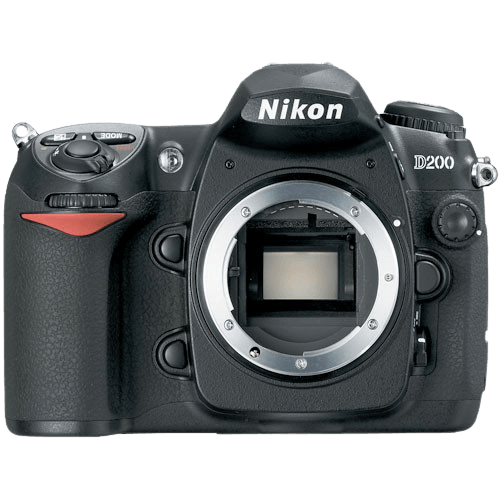Fujifilm FinePix S5 Pro vs Nikon D200 Comparison
Fujifilm FinePix S5 Pro

Nikon D200

In comparing the Fujifilm FinePix S5 Pro and Nikon D200, the latter slightly wins with a score of 37/100, just one point ahead of the FinePix S5 Pro. Both cameras share common specifications such as being DSLR cameras, having the same dimensions of 147 x 113 x 74mm, and weighing 920g. The Nikon D200 stands out for its lower launch price of $1000 compared to the FinePix S5 Pro’s $1200. However, the FinePix S5 Pro was released in 2006, a year later than the D200, which may offer updated technology. Despite the close scores, the Nikon D200’s affordability gives it a slight edge.
Fujifilm FinePix S5 Pro vs Nikon D200 Overview and Optics
The Fujifilm FinePix S5 Pro wins the optics comparison against the Nikon D200 with a score of 43/100, while the Nikon D200 scores 41/100. Both cameras share some common specifications, such as an APS-C sensor size, Nikon F DX lens mount, and no image stabilization.
The FinePix S5 Pro has a 6.1-megapixel sensor, which is lower than the D200’s 10-megapixel sensor. However, the S5 Pro has a higher shooting speed of 5.5, compared to the D200’s 5. The FinePix S5 Pro’s Super CCD sensor type and Real Photo Processor Pro provide better image quality, despite having fewer megapixels. The lack of a DXOMARK score for Fujifilm cameras does not detract from the S5 Pro’s superior performance in this comparison.
On the other hand, the Nikon D200 has a higher resolution with its 10-megapixel sensor, which can be an advantage for those who require larger prints or more cropping options. The D200 also has a DXOMARK score of 64 for its sensor, adding credibility to its image quality. However, its lower shooting speed and CCD sensor type make it slightly inferior to the FinePix S5 Pro in terms of overall optics performance.
In this comparison, the Fujifilm FinePix S5 Pro outperforms the Nikon D200 in terms of optics, primarily due to its superior shooting speed and sensor technology. The Nikon D200, while offering a higher resolution, falls short in other areas that contribute to overall image quality. Therefore, the FinePix S5 Pro is the better choice for those prioritizing optics performance in their camera selection.
Fujifilm FinePix S5 Pro vs Nikon D200 Video Performance
In the comparison between the Fujifilm FinePix S5 Pro and the Nikon D200, it is important to note that neither camera offers video capabilities. Both the Fujifilm FinePix S5 Pro and the Nikon D200 lack this feature. Thus, when considering these cameras, video functionality is not a factor in determining their overall quality or score.
Fujifilm FinePix S5 Pro vs Nikon D200 Features and Benefits
The Nikon D200 comes out ahead of the Fujifilm FinePix S5 Pro with a feature score of 30/100 compared to the Fujifilm’s 17/100. Both cameras possess identical screen specifications, with a 2.5-inch screen size and 230,000-dot screen resolution. Additionally, neither camera has a touchscreen, flip screen, GPS, WIFI, or Bluetooth capabilities.
The Nikon D200’s higher feature score indicates that it has additional features that set it apart from the Fujifilm FinePix S5 Pro. Unfortunately, the provided specifications do not detail what these advantages are. However, the higher score confirms that the Nikon D200 offers more in terms of features than the Fujifilm FinePix S5 Pro.
On the other hand, the Fujifilm FinePix S5 Pro’s lower score does not necessarily mean it is a worse camera. It could have other specifications or qualities that are not reflected in the feature score. However, based solely on the information provided, it is not possible to determine any advantages the Fujifilm FinePix S5 Pro may have over the Nikon D200.
Taking all of this into consideration, it is clear that the Nikon D200 has a higher feature score and offers more than the Fujifilm FinePix S5 Pro. However, it is crucial to consider other factors and specifications before making a final decision on which camera to purchase.
Fujifilm FinePix S5 Pro vs Nikon D200 Storage and Battery
The Fujifilm FinePix S5 Pro outperforms the Nikon D200 in storage and battery with a score of 51/100 compared to Nikon’s 35/100. Both cameras share similarities in storage, having one memory card slot each and accepting Compact Flash (Type I or II) cards. Neither camera offers USB charging.
The FinePix S5 Pro holds a significant advantage in battery life, providing 2438 shots per charge with its NP-150 battery, while the Nikon D200 only delivers 800 shots using its EN-EL3e battery. This difference makes the FinePix S5 Pro a more reliable option for extended shooting sessions.
The Nikon D200, however, does not hold any advantages over the FinePix S5 Pro in terms of storage and battery. The lower score reflects its shorter battery life, which could impact performance during longer shoots.
Considering these factors, the Fujifilm FinePix S5 Pro is the better choice for photographers prioritizing longer battery life and uninterrupted shooting. The Nikon D200 falls behind in this aspect, making it less optimal for extended use.
Fujifilm FinePix S5 Pro vs Nikon D200 – Our Verdict
Are you still undecided about which camera is right for you? Have a look at these popular comparisons that feature the Fujifilm FinePix S5 Pro or the Nikon D200:

